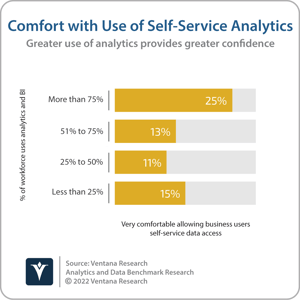When joining Ventana Research, I noted that the need to be more data-driven has become a mantra among large and small organizations alike. Data-driven organizations stand to gain competitive advantage, responding faster to worker and customer demands for more innovative, data-rich applications and personalized experiences. Being data-driven is clearly something to aspire to. However, it is also a somewhat vague concept without clear definition. We know data-driven organizations when we see them — the likes of Airbnb, DoorDash, ING Bank, Netflix, Spotify, and Uber are often cited as examples — but it is not necessarily clear what separates the data-driven from the rest. Data has been used in decision-making processes for thousands of years, and no business operates without some form of data processing and analytics. As such, although many organizations may aspire to be more data-driven, identifying and defining the steps required to achieve that goal are not necessarily easy. In this Analyst Perspective, I will outline the four key traits that I believe are required for a company to be considered data-driven.
At Ventana Research, we believe it takes the right balance of people, processes, information and technology for businesses to succeed in any endeavor. It is important to note from the start, therefore, that the state of being data-driven can only be achieved through a combination of people, processes, information and technology improvement. There are countless data and analytics products and services available that promise to accelerate and improve data processing and analysis. However, the best products in the world will not help if an organization does not also take steps to improve and refine its culture and business processes, as well as the information collected and used to inform decision-making. As such, the first fundamental aspect of being a data-driven organization is creating a data-centric business culture. This means not just using data processing and analytics technologies to make key business decisions but ensuring that data is at the heart of all decision-making processes. As with any organizational ethos, a data-centric culture needs to start at the top. It is well-known that a lack of leadership buy-in can be an impediment to success with data and analytics. Almost 1 in 5 participants (19%) in Ventana Research’s Analytics and Data Benchmark Research said a lack of executive support is a barrier to making improvements to analytics and data. Similarly, the support of executives and business leaders is critical in defining, articulating and demonstrating the values, vision and goals that promote a culture of data-driven optimization and decision-making.
While the impetus may come from the top, a data-centric culture needs to reach all parts of the business if it is to become pervasive. The second fundamental aspect of being a data-driven organization is data literacy, enabled by investment in skills to ensure that people at all levels of an organization can understand and work with data. Less than one-quarter of participants (23%) in our Analytics and Data Benchmark Research said that more than one-half of their workforce uses analytics and business intelligence (BI). The results of increased investment in data skills could be significant in empowering employees to make data-driven decisions and facilitating a data-centric culture. Organizations with the highest proportion of employees using analytics and BI are more confident in allowing business users self-service access to data for analysis, for example. One-quarter of organizations where more than three-quarters of the workforce uses analytics and BI are very comfortable in allowing business users to work with data that has not been integrated or prepared for them by IT. That compares to 15% of organizations where less than one-quarter of the workforce uses analytics and BI.
 As my colleague Dave Menninger noted earlier this year, the solution to increasing and improving the use of data within an organization is not simply training every employee to become literate in using existing data and analytics products. We also recognize the importance of increasing the use of natural language processing and embedded analytics to present data to users in different personas in a format and channel that aligns with their business workflow and objectives, including operational applications. That is why we consider the third aspect of being a data-driven organization to be data democratization. Data democratization is subtly different from increasing data literacy and involves removing barriers that prevent or delay users from gaining access to data. Data democratization results in data being treated as a product that is generated and consumed, either internally by employees or externally by partners and customers. In the latter case, this could mean the creation of new revenue-generating, data-driven products such as subscription-based predictive maintenance for connected devices. For internal initiatives, data-as-a-product has a key role to play in enabling sharing of domain-oriented data as part of a data mesh. While data democratization facilitates access to data, it is not a free-for-all. In recent years, the data catalog has emerged as a fundamentally important component of a thriving data culture that enables search-based data discovery and guided data navigation, as well as data governance controls to enable data stewards to manage and track how data is used in an organization, and by who. I assert that, through 2024, 7 in ten organizations will use data catalog technologies in order to improve data governance and accelerate data-driven decision-making.
As my colleague Dave Menninger noted earlier this year, the solution to increasing and improving the use of data within an organization is not simply training every employee to become literate in using existing data and analytics products. We also recognize the importance of increasing the use of natural language processing and embedded analytics to present data to users in different personas in a format and channel that aligns with their business workflow and objectives, including operational applications. That is why we consider the third aspect of being a data-driven organization to be data democratization. Data democratization is subtly different from increasing data literacy and involves removing barriers that prevent or delay users from gaining access to data. Data democratization results in data being treated as a product that is generated and consumed, either internally by employees or externally by partners and customers. In the latter case, this could mean the creation of new revenue-generating, data-driven products such as subscription-based predictive maintenance for connected devices. For internal initiatives, data-as-a-product has a key role to play in enabling sharing of domain-oriented data as part of a data mesh. While data democratization facilitates access to data, it is not a free-for-all. In recent years, the data catalog has emerged as a fundamentally important component of a thriving data culture that enables search-based data discovery and guided data navigation, as well as data governance controls to enable data stewards to manage and track how data is used in an organization, and by who. I assert that, through 2024, 7 in ten organizations will use data catalog technologies in order to improve data governance and accelerate data-driven decision-making.
.png?width=300&name=VR_2022_Data_Governance_Assertion_2_Square%20(1).png) Encouraging employees to discover and experiment with data is a key component of the fourth aspect of being a data-driven organization: data curiosity. Being data curious means encouraging experimentation and exploration, including data science. An organization that is data curious is constantly testing hypotheses and experimenting with predictive modeling and forecasting, using data to not only answer known business questions but also to discover and explore new business challenges and opportunities. Data curiosity is an important part of the overall data culture and is encouraged and reinforced through collaboration and education: communicating to all parts of the business about data’s potential to transform business processes, develop new products and services and improve operational efficiency through the accelerated and automated processing of data.
Encouraging employees to discover and experiment with data is a key component of the fourth aspect of being a data-driven organization: data curiosity. Being data curious means encouraging experimentation and exploration, including data science. An organization that is data curious is constantly testing hypotheses and experimenting with predictive modeling and forecasting, using data to not only answer known business questions but also to discover and explore new business challenges and opportunities. Data curiosity is an important part of the overall data culture and is encouraged and reinforced through collaboration and education: communicating to all parts of the business about data’s potential to transform business processes, develop new products and services and improve operational efficiency through the accelerated and automated processing of data.
The results of our Analytics and Data Benchmark Research show that only 18% of organizations can be considered part of the Innovative top tier when it comes to the use of analytics and data. For those that aspire to be part of this select group, there are multiple opportunities for improvement and transformation. This Analyst Perspective only scratches the surface. We will explore further details in the future. In the interim, I recommend that all organizations at least investigate the best practices operated by data-driven companies in relation to data culture, data literacy, data democratization and data curiosity, with a view to improving their use of data and analytics.
Regards,
Matt Aslett

 As my colleague Dave Menninger
As my colleague Dave Menninger .png?width=300&name=VR_2022_Data_Governance_Assertion_2_Square%20(1).png) Encouraging employees to discover and experiment with data is a key component of the fourth aspect of being a data-driven organization: data curiosity. Being data curious means encouraging experimentation and exploration, including data science. An organization that is data curious is constantly testing hypotheses and experimenting with predictive modeling and forecasting, using data to not only answer known business questions but also to discover and explore new business challenges and opportunities. Data curiosity is an important part of the overall data culture and is encouraged and reinforced through collaboration and education: communicating to all parts of the business about data’s potential to transform business processes, develop new products and services and improve operational efficiency through the accelerated and automated processing of data.
Encouraging employees to discover and experiment with data is a key component of the fourth aspect of being a data-driven organization: data curiosity. Being data curious means encouraging experimentation and exploration, including data science. An organization that is data curious is constantly testing hypotheses and experimenting with predictive modeling and forecasting, using data to not only answer known business questions but also to discover and explore new business challenges and opportunities. Data curiosity is an important part of the overall data culture and is encouraged and reinforced through collaboration and education: communicating to all parts of the business about data’s potential to transform business processes, develop new products and services and improve operational efficiency through the accelerated and automated processing of data.








